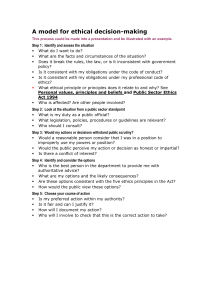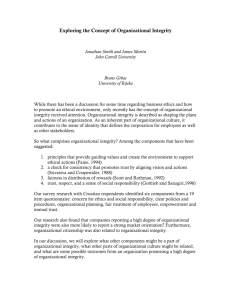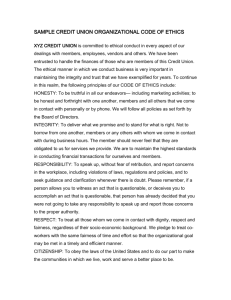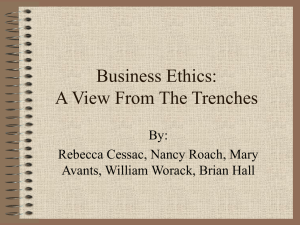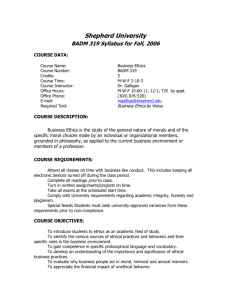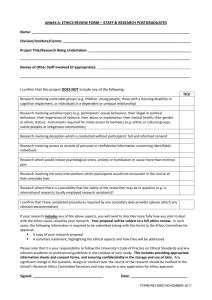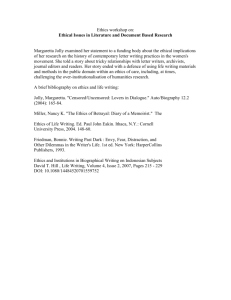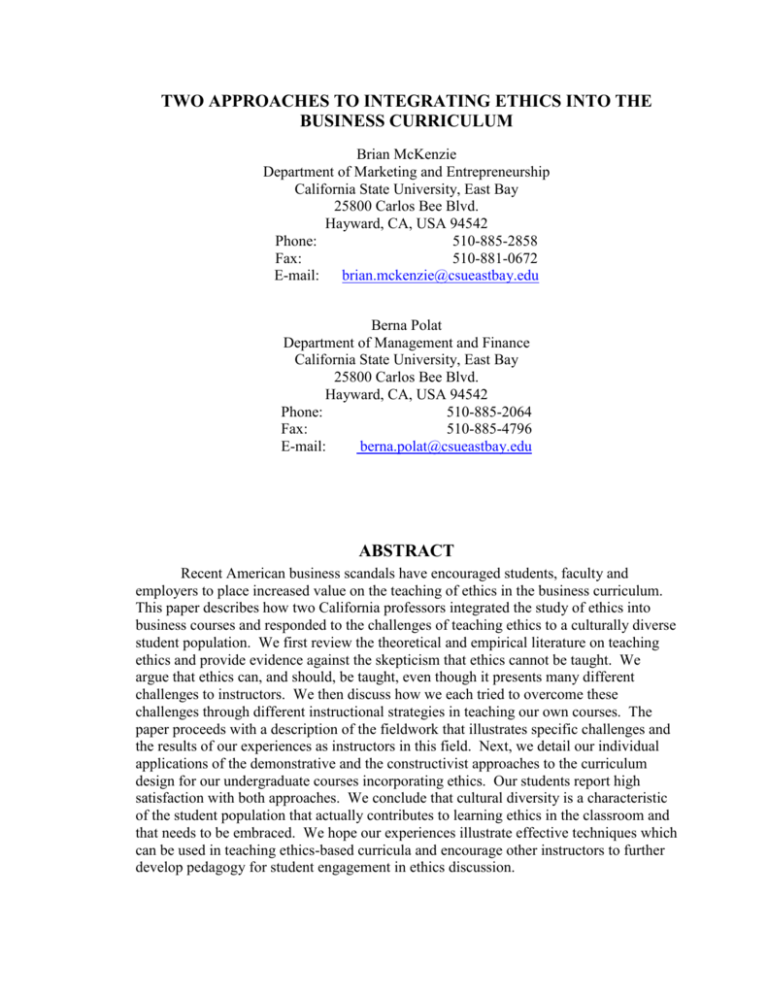
TWO APPROACHES TO INTEGRATING ETHICS INTO THE
BUSINESS CURRICULUM
Brian McKenzie
Department of Marketing and Entrepreneurship
California State University, East Bay
25800 Carlos Bee Blvd.
Hayward, CA, USA 94542
Phone:
510-885-2858
Fax:
510-881-0672
E-mail:
brian.mckenzie@csueastbay.edu
Berna Polat
Department of Management and Finance
California State University, East Bay
25800 Carlos Bee Blvd.
Hayward, CA, USA 94542
Phone:
510-885-2064
Fax:
510-885-4796
E-mail:
berna.polat@csueastbay.edu
ABSTRACT
Recent American business scandals have encouraged students, faculty and
employers to place increased value on the teaching of ethics in the business curriculum.
This paper describes how two California professors integrated the study of ethics into
business courses and responded to the challenges of teaching ethics to a culturally diverse
student population. We first review the theoretical and empirical literature on teaching
ethics and provide evidence against the skepticism that ethics cannot be taught. We
argue that ethics can, and should, be taught, even though it presents many different
challenges to instructors. We then discuss how we each tried to overcome these
challenges through different instructional strategies in teaching our own courses. The
paper proceeds with a description of the fieldwork that illustrates specific challenges and
the results of our experiences as instructors in this field. Next, we detail our individual
applications of the demonstrative and the constructivist approaches to the curriculum
design for our undergraduate courses incorporating ethics. Our students report high
satisfaction with both approaches. We conclude that cultural diversity is a characteristic
of the student population that actually contributes to learning ethics in the classroom and
that needs to be embraced. We hope our experiences illustrate effective techniques which
can be used in teaching ethics-based curricula and encourage other instructors to further
develop pedagogy for student engagement in ethics discussion.
INTRODUCTION
American business scandals, such as the collapse of Enron, Tyco, WorldCom, and
the jailing of Martha Stewart for obstructing justice and lying to investigators, highlight
the need for ethics education in business schools. Some of the key figures in these
scandals had MBAs from very prestigious schools, resulting in a decrease in public
confidence in business degrees and the institutions providing them. Consequently, the
Association to Advance Collegiate Business Education (2005, p.11) stresses the
importance of ethics in business education by listing as one of the criteria for
accreditation: “The institution or the business programs of the institution must establish
expectations for ethical behavior by administrators, faculty and students.”
A survey of New England business school graduate students (Crane, 2004)
showed that 83% of the respondents thought a required ethics course should be taught
and 85% thought that they would learn something of value from this course. Following
the same trend, business schools have lately been using stricter and more thorough
background checks in admitting students to their MBA programs, with the goal of
weeding out candidates with flexible morals. Falsifying material on one’s application
and resume is grounds for denial of admission to the best business schools. Similar kinds
of ethics questions are being emphasized in job interviews to help recruiters disqualify
candidates with dishonest inclinations (Alsop, 2006). According to a Wall Street
Journal/Harris Interactive recruiter survey, 74% of respondents rated personal integrity
and knowledge about corporate ethics as “very important”, while 24% said they are
“somewhat important” (Alsop, 2006). Thus, it would appear that students, faculty and
employers are all placing increased value on the teaching of ethics in the business
curriculum.
The nature of ethics is commonly structured as an answer to Socrates’ question
“how ought one to live?” As such, the characteristics of ethical behavior are normative
and culturally relative. This paper explores the challenges faced by two California
professors who set out to integrate the study of ethics in their business curricula. Their
educational processes were complicated by the cultural diversity of their student
population, the success-focus of the local business environment, and the multi-tasking
cognitive propensity of their students.
The paper proceeds as follows. First, the pedagogical literature surrounding
ethics is reviewed. Then, the strategies employed by the two instructors are described.
Fieldwork uncovers the challenges and successes each instructor experienced in their
approach to teaching and describes how each modified his/her curriculum over time.
Finally conclusions are drawn and the implications of this study are discussed.
LITERATURE REVIEW
Williams and Dewett (2005, p. 109) have reiterated an often stated claim: “you
can’t teach business ethics.” They noted three common reasons for this skepticism: (1)
values are formed prior to higher education, (2) ethics are irrelevant in a business context
and (3) teaching business ethics does not work (Williams & Dewett, 2005, pp.110-112).
However, Williams and Dewett also noted that there is empirical evidence to counter
each of these claims.
While it is often thought that students have formed their ethical values prior to
entering business school, King and Mayhew’s (2002) review of 172 studies that used the
Defining Issues Test identified 29 studies showing that college education is positively
associated with moral development. The evidence of studies measuring differences
between academic disciplines is inconclusive, however, the implication of King and
Mayhew’s (2002, p. 266) study is that colleges can offer an excellent context for the
stimulation of moral development.
Williams and Dewett (2005, pp. 110-111) counter the claim that ethics are
irrelevant in a business context by arguing that social responsibility is embedded in the
self interest of all business professionals. They note that Friedman (1975), Smith (1776,
p.111) and others believe that “both self-interested behavior and ethical behavior are
essential for societal wealth maximization.” Norman and MacDonald (2004) reiterate
this argument saying that the idea of triple bottom line is not novel, but rather
synonymous to corporate social responsibility.
The skepticism of the ability to teach business ethics stems from recent publicity
of the unethical conduct of American companies such as Enron, WorldCom, and Tyco, in
spite of key company employees having MBA degrees from top schools. The public is
attributing at least part of the reason for the moral collapse of the companies on the
ineffectiveness of ethics education in these business schools. However, Trevino (1986)
has proposed that ethical decision making is a complex interaction of cognitive factors,
individual moderators and situational moderators. Trevino’s model draws on the work of
Kohlberg (1984) which shows that the reasoning for moral decision making becomes
more complex and sophisticated as the individual’s intellectual capacity develops
(Trevino, 1986, p. 604). This model suggests that the reasoning for ethical decisionmaking can be improved by teaching guidance for moral judgment.
While the arguments presented by Williams and Dewett (2005) have overcome
the skeptical claim that you can’t teach business ethics; a secondary skepticism has
developed over the difficulty of teaching this subject. Sims (2004, p. 201) has pointed
out an issue which is not addressed in Williams and Dewett’s (2005, pp.110-112) critique
of ethics education: many of the issues addressed teaching business ethics can generate
powerful emotional responses from students. This is particularly true when dealing with
a student body coming from a multi-cultural environment with little knowledge of
business practice. Nill and Schibrowsky (2005, p. 68) have noted that the ethical
behavior of a person is grounded in his or her socialization. Their research shows
empirical evidence supporting a model in which the perceived moral intensity, the
corporate culture and the reward system drive ethical decision making. Students from
differing cultures will have different perceptions of the moral intensity of ethical
situations. Moreover, undergraduate students have very little exposure to corporate
culture. As a result, the ethical decision making of students is likely to be driven
primarily by the reward system of the organization in which they find themselves. This
leads to many students perceiving a trade-off between profitable and ethical corporate
behavior. Students also seem to believe real-world situations are different from
classroom situations in terms of their ethical implications.
Sims and Brinkman (2003, p. 69) noted that business ethics is essentially a selfcriticism of business practice. Thus, business ethics cannot be taught in a vacuum, but
rather must be contextualized into a larger discussion of business practices. Sims and
Brinkman (2003, p.78) recommend that business ethics should be integrated into all
courses of a business curriculum. Unfortunately, this ideal is not common practice in
business schools. Thus, professors who attempt to integrate ethics into their curriculum
are faced with the challenge of both teaching the course material and teaching criticism of
this same course material.
This summary shows some of the difficulties that can be expected by instructors
when trying to incorporate a strong ethical basis into their teaching. In this section, we
have described the underlying assumptions of the general notion that ethics cannot be
taught. While we acknowledged the difficulties in teaching ethics, we argued that ethics
not only can be taught but also should be taught in business schools and discussed
empirical evidence supporting our claim. The balance of this paper describes how we
addressed and overcame these difficulties in our own teaching of ethics at a California
State University.
INSTRUCTIONAL STRATEGIES
Dr. Berna Polat has utilized a demonstrative approach in her course syllabus for
Business, Government, and Society. In this curriculum, students’ multi-tasking bias is
intensified by the success-focus of the local business environment. Consequently,
students have sometimes misperceived ethics-based classes as being over taught. To
address this issue, Polat used exercises, readings, news stories, and real-life
cases/vignettes that demonstrate the need for ethics-based curricula and for business
objectives more expansive than profit maximization. In-class and online discussions
were critical in allowing the course to develop along student interests. Discussions also
ensured that cultural diversity contributed to the class content by exposing less popular
perspectives, thereby providing more complete analyses of issues.
Dr. Brian McKenzie has taken a constructivist approach in the design of his
curriculum for Environmental Marketing. The topic of environmental marketing is
generally seen by scholars as ethically based (Coddington, 1993; Tokar, 1987). To
overcome students’ multi-tasking cognitive bias, McKenzie asked the class to develop
their own course syllabus. Topics chosen by the students for their syllabus included
history of environmental marketing, current ethical business environment, core values of
environmentalism, creating environmentally friendly products, strategic environmental
marketing and societal marketing. To address the cultural diversity of the student
population, student projects included learning journals, research projects, field trips and
class leadership exercises. Students addressed the success-focus of the local business
environment by discussing alternative life-paths such as the simple living movement.
FIELDWORK
This paper demonstrates the complexity of fulfilling the mandate created by
AACSB to inculcate expectations for ethical behavior in the business curriculum. It also
reveals effective techniques which can be used in the creation of ethics-based curricula.
The following section describes the field experiences of two professors at a California
State University as they set out to incorporate ethics instruction into their business
curriculum.
Brian McKenzie’s Experience
In 2004, Brian McKenzie was asked to teach an undergraduate course in
environmental marketing. While McKenzie had prior experience teaching courses in
environmental entrepreneurship, he did not have a solid theoretical or conceptual grasp of
environmental marketing. Environmental entrepreneurship has, at its core, the notion of
change. However, it appeared that the notion central to most environmental marketing
texts was either that of apology or perception change. The underlying question that
remained after much research into the topic was “what is environmental marketing?”
McKenzie chose to pose this question to his students in the form of a constructivist
approach to curriculum creation.
Constructivist education was introduced to the students in the first class of each
offering of the course through a brief history of the development of universities in the
twelfth century. The opposing models of University of Bologna in Italy and the
University of Paris in France were described. The University of Paris centered on
Chartres Cathedral. After a struggle between the church, townspeople and scholars, the
university finally won the power to regulate student life and to determine the criteria for
the degree. The Papal Bull of 1231 insured the faculty’s right to control examinations
and licensing of teachers. The University of Bologna began as a number of student
associations. These associations negotiated with the teachers gilds concerning fees and
set up the rules for teaching. McKenzie suggested to the students that most or all of their
previous courses followed the Parisian model. However, this course was going to follow
the Bolognese model. Students were to develop their own curriculum and could decide
whether or not to keep McKenzie as their professor.
An unexpected difficulty was encountered in overcoming the student’s apparent
lack of belief in their own empowerment. Students reacted with demands like: “we don’t
want any exams” and “we don’t want to have to buy a textbook”. McKenzie’s reaction to
these demands was “sure if you don’t want exams (textbooks) then we won’t use exams
(textbooks)”. However, McKenzie countered with the challenge of forcing the students
to state what they did want. The answer to this question was surprising: the students
wanted discussion, field trips and guest speakers. After three class sessions, the syllabus
was drawn up, voted on and accepted by all students.
The task and responsibility of creating their own curriculum assisted students in
developing critical awareness. This critical awareness extended into key elements of a
student’s business life: the management of assignments and the development of a fair
grading system.
In the three years that McKenzie taught this course, the student syllabus consisted
of discussion and weekly research for discussion, weekly learning journals, participation
in a class leadership exercise and participation in a presentation describing fieldwork.
Discussion was focused around weekly topics, such as, what is environmental marketing;
the history of environmental marketing; current business environment; core values of
environmental marketing; creating environmentally friendly products; strategic
environmental marketing; societal marketing; and applying environmental marketing.
Each student agreed to post information that he or she had researched to a discussion
board on the Blackboard course management site. Students also agreed to post weekly
learning journal entries to their professor. This use of Blackboard democratized the
traditional autocratic use of course management software, reflecting the students feeling
of empowerment. McKenzie was surprised to discover that students assigned themselves
writing and research load equivalent to 40 pages of text in a ten week term. Each week, a
group of students took on leadership of classroom discussion. The format of classroom
discussions ranged from traditional lectures to open ended discussions. Students used a
Blackboard forum to organize field trips. These field trips ranged from a visit to the
district Environmental Protection Agency branch to a tour of a local automaker.
Students developed a unique outcomes assessment. For example, in the second
years of McKenzie’s facilitation of this course, assignments were classified into two
groups: core assignments and scholarly assignments in recognition that there were two
types of students in the class: those who just wanted to pass and those who wanted to get
“A” grades. The core requirements were made up of attending all Monday and
Wednesday sessions, completing all discussion submissions, completing weekly learning
journals, participation in a class leadership exercise and participation in a presentation
describing fieldwork. The scholarly requirements were made up of attending Friday
sessions and the development of four research briefs.
Student assignments were graded on a scale of (E) excellent, (S) satisfactory and
(U) unsatisfactory. One modification was found to be necessary to the student grading
scheme: the inclusion of redemption. Redemption meant that a student who received a U
grade on one assignment could use an E grade on another similar assignment to bring
each to an S level. McKenzie felt this was a necessary condition to avoid unnecessary
penalties to students who missed or misunderstood any one particular assignment.
In the second year’s running of this course, fourteen students out of a class of 45
opted for the scholarly program. These students met each Friday morning throughout the
quarter and engaged in a program of rigorous research. This research involved surveying
the literature, developing a theoretical perspective on environmental marketing and
critiquing other students’ theoretical perspectives. Since this group was not hampered by
the social pressures of a larger class, they performed at a very high level.
In all three years, the students performed at a better than satisfactory level, both in
terms of the grading scheme they developed and in comparison to comparable Marketing
classes taught by the instructor. Class averages stood at the C+ to B- range found
throughout the College. Students’ reactions to the course were uniformly positive.
McKenzie received comments such as:
I enjoyed the class. I learned more by discussing the concepts in class
than standard class teaching
The method the instructor used to make the class an educational and
engaging experience really shows his talent and personality
Great method for getting students involved in the topic. Very fun class.
The professor always made it exciting
Student evaluations for the quality of instruction in the course were 1.23 and 1.03 on a
scale where 1 is the highest evaluation possible and 5 is the lowest evaluation possible.
McKenzie enjoyed the experience of teaching this course and received a great
deal of insight both into the subject matter and into the effectiveness of a reflective
approach to teaching. This constructivist curriculum design encouraged reflection on the
fundamental elements of teaching. This reflection facilitated new understanding and
curriculum change in all of McKenzie’s courses. The reflective nature of teaching this
course also offered important new insights in research, which have led to theoretical and
pedagogical academic papers.
Berna Polat’s Experience
Berna Polat has used a student-centered approach, primarily based on discussions
and case studies in the development of the curriculum of her Business, Government, and
Society course. The course was a general survey class with the underlying themes of
ethics, moral development, and social responsibility and included topics about how firms
interact with the rest of society and the government. Polat took a critical management
studies approach for this undergraduate core course. Polat had taught this course
previously at another institution and had also participated in the development of a “bestpractices” curriculum for the instruction of the course at that institution. She designed
the California State University course to fit the needs of the student body while
incorporating the best practices into her teaching.
Polat started out the course by talking about the need for ethics education in the
business curriculum. This was absolutely necessary to make the students aware of their
own judgments and biases coming in to the class. As mentioned above, some students
view ethics as an over taught subject and they need to be convinced of the need for ethics
education at this level by getting insight into how the course can help them in their
professional lives. To overcome this student bias, the course incorporated current news
stories about companies the students know about or heard of in their daily or professional
lives. Polat felt that if the cases or subject companies were those the students could relate
to or which evoked an emotional or controversial response, then recall and student
engagement would be greater. A major objective of active learning designs is student
engagement to facilitate understanding of the material.
The focus of the course was on skill development and improvement of selfawareness as well as topical knowledge and understanding of issues and compliance. In
the first few sessions, Polat explained how class structure and design would contribute to
students’ understanding of topics. For example, the instructor pointed out the
experiential value in group processes in terms of learning to manage diversity, making
decisions with everyone involved, reaching consensus (and not necessarily agreement),
dealing with tradeoffs, and handling problems. The group setting provided invaluable
lessons for learning in this context. The issues were brought up and discussed in class
and online (Blackboard) discussions. The online discussion board was a great
supplement to class discussion. Students continued discussions they had started in class,
bounced ideas off each other, provided context, commentary, or links on issues, or just
freely exchanged material and opinions. In order to stimulate contribution on Blackboard,
the instructor evaluated online content similar to class participation.
The Business, Government, and Society course was developed using an
evolutionary, strategic, and global perspective. An evolutionary approach makes sense
since for most content included in this course; the past has shaped the present, and most
likely the future. For example, in order to understand issues of discrimination in the
workplace, we need to know how American history has shaped this issue, beginning with
the Civil War. The course topics followed the same logic. Students first built a
foundation with by exploring different models of the business-government-society
relationship, as well as the chronology and historical context of how these models were
developed. After learning about the forces in the external environment of business, the
internal context of the firm was investigated. Issues of corporate governance, power, and
social responsibility were examined. Building upon this foundation, the students next
turned their attention to narrower topics that studied the relationship of business firms
with individual components of their external environment, such as the government,
politics and the political system, the natural environment, employees, and customer.
Polat had the main objective of exposing the students to some of the ethical and
moral concerns surrounding business firms from critical perspectives. This objective was
accomplished through in-class activities and assignments. At the end of the quarter,
students seemed to have a heightened awareness of the ethical content of managerial
decisions, as well as some of the issues currently on the public agenda. Students had
developed an understanding of the necessity of balancing the goals of business with
socially and legally responsible corporate behavior. A secondary objective of the course
was to provide a forum for the students to practice discussing ethical and moral issues. In
companies that have an unethical climate, the corporate culture seems to be a major
contributor to why things get out of hand (Velasquez, 2006). “Moral muteness” (Steiner
& Steiner, 2006), or lack of communication on ethical concerns, can very well lead to
ultimate deterioration of the moral climate in the firm, as well as discouraging
whistleblowers from exposing the situation. The best way to combat this lack of
communication is to give future business leaders the vocabulary and skills to
communicate on these issues. This objective was accomplished in Polat’s pedagogy by
emphasizing discussion both in the classroom and online, and by using group act ivies.
For example, classroom debates presented an opportunity for students to practice building
and defending a point of view, and to question the assumptions and the validity of an
opposing argument.
The class size of the Business, Government, and Society course was 55-65
students in each quarter the course was offered. Student grades averaged around B-,
which is about the average for this university. Even though this was a required course
and the course was rated difficult by many of the students, course evaluations pointed to a
high level of student satisfaction. For Fall 2004 and Spring 2005, the first two times the
instructor taught the course, evaluations were at 1.64 and 1.20 on a scale of 1-5 where 1
is the highest evaluation possible. Polat also had very positive comments from the
students regarding the topic, the instructor, and the overall learning experience in the
class:
The course was fun and a great learning experience.
The instructor was great. She made the class really interesting.
This was one of my most challenging classes but I learned a lot.
I like the fact that she gets her students to really think about the issues!
She doesn’t just lecture but wants her students to apply the issue.
CONCLUSIONS
This paper has described the experiences of two California professors, who set out
to integrate the study of ethics in their business curricula. Both professors found that the
educational process was complicated by the cultural diversity of their student population,
the success-focus of the local business environment and the multi-tasking cognitive
propensity of their students. The fieldwork examples show that different approaches can
be used to successfully teach business ethics. Dr. Brian McKenzie’s constructivist
approach in the design of his curriculum for Environmental Marketing demonstrated how
students could be empowered to bring critical management thinking into the classroom.
Dr. Berna Polat’s use of a demonstrative approach in her course syllabus for Business,
Government, and Society revealed how the natural propensity for students to multi-task
could be utilized to bring out the complexity of ethical decision-making.
The success which both instructors achieved in the classroom demonstrates both
that ethics can be taught and that students can and do enjoy the process of ethics training.
Both instructors found that successful ethics training was based on the need to expand
business objectives beyond the scope of profit maximization. Both instructors found that
the cultural diversity of their classroom contributed to the class content by exposing less
popular perspectives, thereby providing more complete analyses of issues. It appeared
that students were very open to discussing non-conventional business models and
alternative life-paths such as the simple living movement. The multi-tasking cognitive
propensity of the students was used to advantage by both instructors by including on-line
discussion in their course requirements. This use of media allowed students to
incorporate analysis of ethical situations into their active intellectual lives, as well as
informing the instructors of the needs and interests of the students and allowing them to
customize the courses accordingly.
Both instructors found that they could take courses, whose syllabi were not
specifically designated as ethics courses, and mold them into ethics-based training. The
success in both cases is demonstrated in the positive student comments and the high
ratings received by the instructors for the course evaluations.
DISCUSSION
The authors of this paper have described two very different approaches that they
have used to incorporate ethics into their business curriculum. They do not intend their
experiences to be used as models for ethics training, but rather hope that their examples
will encourage other instructors to experiment in the development of ethics in the
business curriculum. The success which these two instructors achieved should be seen as
an indication of the opportunities that are available to develop exciting and relevant
student participation in ethics discussion.
It should be noted that the students and the teaching environment of this
California State University are relatively unique. The culture of the community is one of
tolerance of diversity of opinion. In fact, the city in which this University is located has
as its motto: “no room for racism”. The university has no racial majority and most of the
students are from first generation immigrant families. This demographic encourages
embracing student diversity through openness of discussion and tolerance for the
opinions of others. Both instructors have tried to incorporate this diversity into their
course designs using different techniques of customization and interactivity.
The examples set out in this paper offer a broad range of settings for the inclusion
of ethics training into the business curriculum. It is hoped that this range will serve as an
example of what is pedagogically possible in this field.
REFERENCES
Alsop, R. (2006). Recruiters are holding MBAs to higher standards of integrity.
CareerJournal.com, the Wall Street Journal, accessed on 7/28/2006.
Association to Advance Collegiate Business Education. (2005). Eligibility procedures
and accreditation standards for business accreditation. Tampa, FL: Association
to Advance Collegiate Business Education.
Coddington, W. (1993). Environmental marketing: Positive strategies for reaching the
green consumer. New York, NY: McGraw-Hill.
Crane, F. G. (2004). The teaching of business ethics: An imperative at business schools.
Journal of Education for Business, 79(3), 149-151.
Friedman, M., & Selden, R. T. (1975). Capitalism and freedom: Problems and prospects;
proceedings of a conference in honor of milton friedman. Charlottesville:
University Press of Virginia.
King, P. M., & Mayhew, M. J. (2002). Moral judgement development in higher
education: Insights from the defining issues test. Journal of Moral Education,
31(3), 247-270.
Kohlberg, L. (1984). The psychology of moral development: The nature and validity of
moral stages (1st ed.). San Francisco: Harper & Row.
Nill, A., & Schibrowsky, J. A. (2005). The impact of corporate culture, the reward
system, and perceived moral intensity on marketing students' ethical decision
making. Journal of Marketing Education, 27(1), 68-81.
Norman, W., & MacDonald, C. (2004). Getting to the bottom of "triple bottom line".
Business Ethics Quarterly, 14(2), 243-262.
Sims, R. R. (2004). Business ethics teaching: Using conversational learning to build an
effective classroom learning environment. Journal of Business Ethics, 49(2), 201211.
Sims, R. R., & Brinkmann, J. (2003). Business ethics curriculum design: Suggestions and
illustrations. Teaching Business Ethics, 7(1), 69-86.
Smith, A. (1776). An inquiry into the nature and causes of the wealth of nations. London,
UK: Printed for W. Strahan and T. Cadell.
Steiner, G. A., & Steiner, J. F. (2006). Business, Government, and Society, A Managerial
Perspective (11th ed.). McGraw-Hill Irwin.
Tokar, B. (1987). The green alternative: Creating an ecological future. San Pedro, CA:
R. & E. Miles.
Trevino, L. K. (1986). Ethical decision making in organizations: A person-situation
interactionist model. Academy of Management Review, 11(3), 601-618.
Velasquez, M. G. (2006). Business Ethics (6th ed). Pearson Prentice Hall
Williams, S. D., & Dewett, T. (2005). Yes, you can teach business ethics: A review and
research agenda. Journal of Leadership & Organizational Studies, 12(2), 109121.


